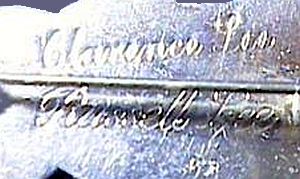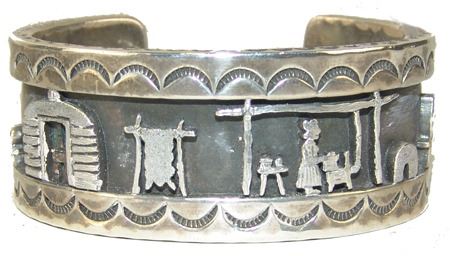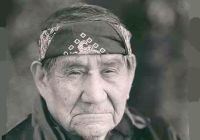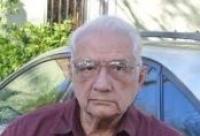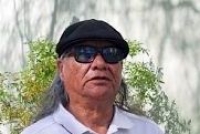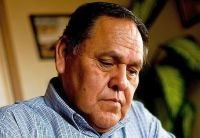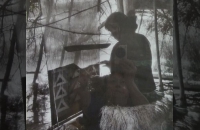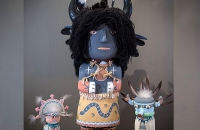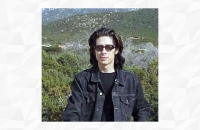Clarence Lee
Navajo Silversmith
Born in 1952 in Ft. Defiance, AZ, Clarence Lee was the second oldest of six children. His parents, Tom and Emma Rose Lee raised their children in Twin Lakes, NM. Currently, all his siblings work with silver to one degree or another with the exception of a sister who works in the health care system.
Clarence learned his craft from his late father Tom Lee who built and owned a Trading Post in Twin Lakes and learned how to make silver jewelry to supplement his income when business at the Trading Post was slow. Tom Lee fought in the Pacific Theatre during World War II, was a POW for four years and a survivor of the infamous “Death March of Bataan.” He later became New Mexico’s first Native American State Senator. Clarence’s mother, Emma was recognized in her own right as the maker of the first Navajo Nation Flag.
Clarence discovered his love of art work in elementary school when a teacher saw promise and encouraged him to pursue his talent. Later on at Tohatchi High School in New Mexico he met his first real art teacher Mrs. Hale. Clarence favored his art classes over academic classes because he suffered from dyslexia. In school he made metal sculptures and worked in oil and watercolors. (Clarence still paints occasionally.)
Mrs. Hale also saw potential yet admonished him, “Don’t start giving stuff away.” Her comments did not discourage him and while he was still in high school continued selling his jewelry to teachers. In addition to his art, Clarence was interested in rodeo and participated in calf and team roping events. Throughout his high school years, Clarence continues to help his father sell traditional jewelry. When financial pressures grew Clarence left school just short of his high school graduation to support his family.
His first pieces of silver work were traditional hammering and stamp work set with stones. Clarence developed his own unique style almost by accident when he shaped a piece of silver resembling a dog. “I did that for eight months and sort of fell over backwards into storyteller style. I made my first bracelet and pin. I didn’t set any stones in my work until later.”
His ideas come from his childhood memories of summers spent with his great grandmother at her summer home in the mountains. He remembers herding sheep and cattle near his home with friends and relatives. Images of windmills, water barrels, old trucks, wood stoves, dogs and rabbits are reflected in his artwork today. Along the way he has added whimsical animals, cowboys, dancers, children and many other images to his collection.
Clarence prefers to sell his jewelry at Indian shows and present his work in competitions and exhibitions. HIs first show was at the Grand Canyon in Arizona. In early years he struggled to make a name in the art world and support his family. Fortunately, the first few shows provided the emerging silversmith encouragement. “I got a good response and it just opened up from there.”
His first competitive show was at the Navajo Nation Fair where his work garnered a first place ribbon in 1977. “ I started signing using an engraver at the beginning, using my family’s registered brand stamp. Using the brand was my dad’s idea, but by 1988 I added my own signature.”
In 1976, Clarence married and later that year his son Russell was born. By 1980 Clarence was a divorced single parent raising his four year old son and began taking his son along to all his shows.
“When Russell was about ten or so he wanted a toy he saw at the mall. I told him you have to earn it by selling something first.” From there Russell was encouraged to try his hand as a silversmith. Russell followed his father’s footsteps and eventually entered various junior competitions winning numerous awards for his work. Russell hoped to go to college after he graduated from high school but during his senior year Russell’s responsibilities in the family jewelry business began to rapidly grow. Russell postponed his college plans to tend the family business, a business that has not slowed down since. Now as an adult, Russell helps full time with the jewelry business work. An apprentice and talented artist in his own right, Russell fashions most of the tiny figures his father incorporates into his storyteller images.
Three museums currently display pieces made by Clarence and Russell. You can see a bracelet on display at the San Diego Museum of Man in San Diego, California. In June 2006, the Eiteljorg Museum of American Indians and Western Art in Indianapolis, Indiana purchased the 3-D card holder, “Mr. Yazzie goes to town” that will remain in their permanent collection. There are also several pieces on display at the British Museum in London, England.
Clarence passed away February, 2011.

